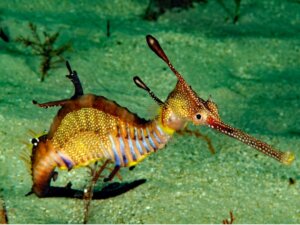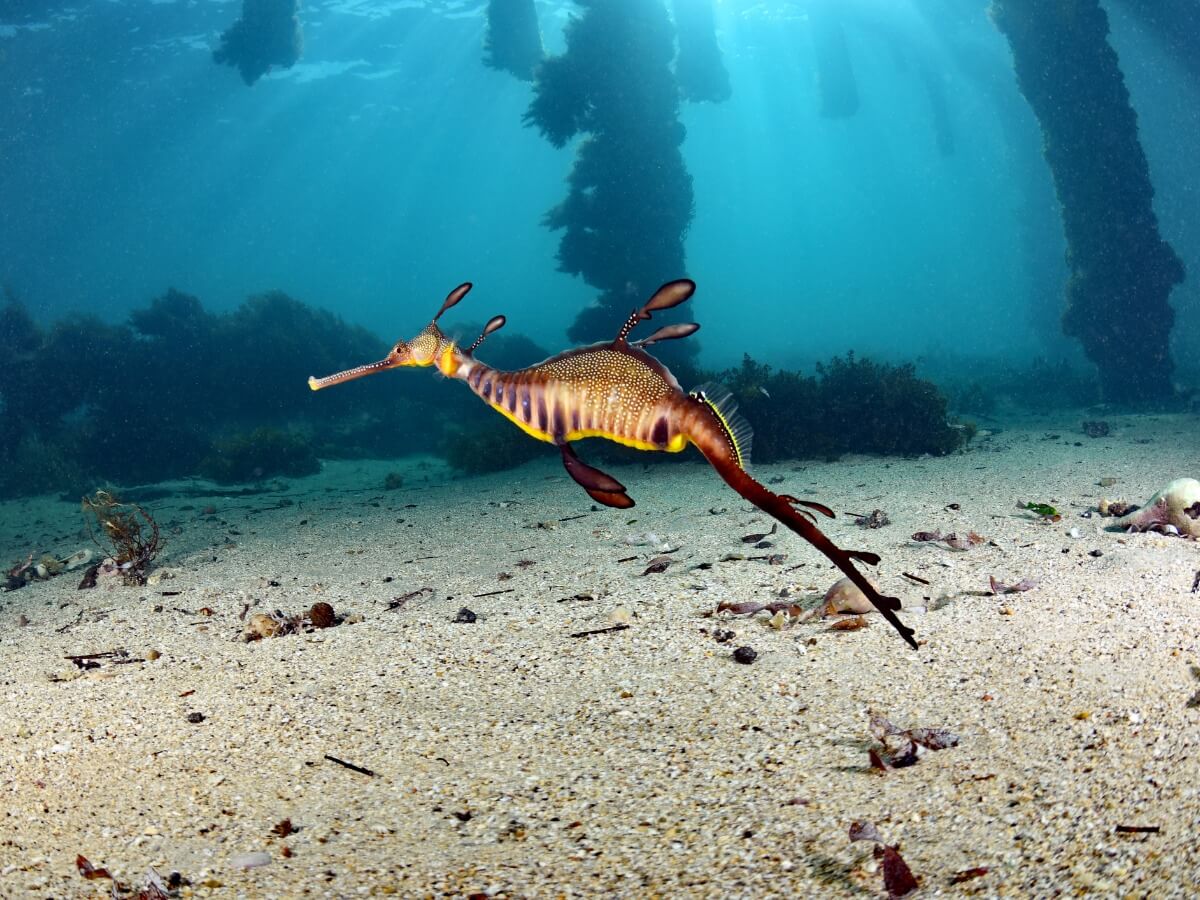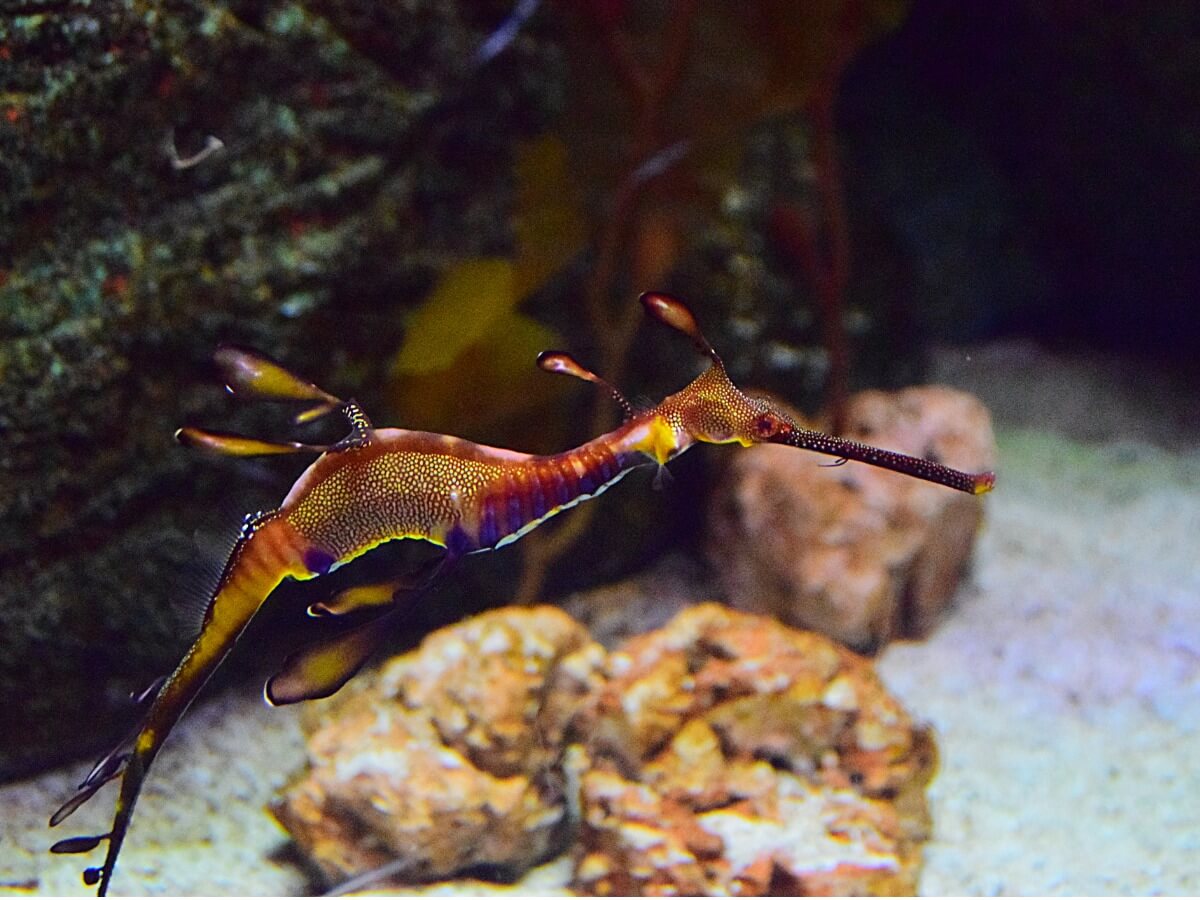The Sea Dragon: Habitat and Characteristics


Written and verified by the biologist Samuel Sanchez
The sea dragon (Phyllopteryx taeniolatus) is a fish in the Syngnathidae family, which also includes seahorses and pipefish. The Syngnathidae represent a total of 307 species, divided into 57 different genera. The sea dragon is one of the 2 members of the genus Phyllopteryx, along with its relative the red sea dragon (Phyllopteryx dewysea).
These animals stand out for their alien morphology and their unique habits. These are very different from those of the rest of the actinopterygian species. If you want to know more about them, keep reading.
Sea dragon habitat
As we’ve said, the sea dragon is a Syngnathidae. All members of this family are marine and inhabit the tropical seas of the world. Most species occupy coastal and shallow waters, although there are some that enter open ocean areas. In addition, many of them are associated with algae of the genus Sargassum.
For its part, the sea dragon (Phyllopteryx taeniolatus) is endemic to the coastal waters of Australia, specifically the Eastern Indian Ocean, the Southern Ocean and the Western South Pacific Ocean. It’s closely associated with rocky surface reefs. However, you can also find it in grasslands with abundant algal vegetation.
Although these requirements may seem very generic, the sea dragon is very specialized and lives in a single type of environment. To accommodate a population, the waters must be between 12 and 23 ºC and the depth cannot exceed 50 meters (164 feet). In general, these animals inhabit the water column at 8-12 meters (26-40 feet) from the surface.
Sea dragons are highly specialized animals in the environment they live in. However, minimal changes in the ecosystem could promote its disappearance.

Physical characteristics
All Syngnathidae are characterized by having elongated snouts, fused jaws, the absence of pelvic fins and being covered with hardened plates, like bony armor. Due to their external protection, they’re slower than other actinopterygians. However, they have a surprising and very exact range of motion when swimming.
Phyllopteryx taeniolatus reaches a maximum length of 45 centimeters (17 inches) and has a very elongated body, with a tubular head region and mouth. It has two very pronounced spines above its eyes and a variable number of dorsal appendages, which make it look like seaweed. On the other hand, it also has a series of vertical bluish bands near the cephalic region and the belly.
There are no subspecies of sea dragons, but it can be confused with one of its more immediate relatives: the foliated sea dragon (Phycodurus eques). This species differs from the one that concerns us today by having many more appendages and by showing a lighter color.
Water dragons have strange bodies. Thanks to their appendages, they look like seaweed floating adrift in the water column.
Sea dragon behavior
Due to its elongated body and body plates, this fish moves very slowly. Therefore, it relies only on its appendages and its shape to go unnoticed in the environment and not attract the attention of possible predators. Sea dragons lack a prehensile tail – unlike seahorses – so they simply drift around.
They’re very passive and peaceful animals with a reduced ability to maneuver in the water column. Although they don’t have specific predators, their clumsiness can take its toll: dead specimens are sometimes found stranded on the beaches. In addition, as studies indicate, they tend to be solitary fish, although pairs and groups are sometimes observed.
Feeding
The Syngnathidae have fused jaws in the form of a single conical structure, so their mouth is shaped like a very elongated “tube”. As a result, they can’t chew or swallow in the typical ways other actinopterygians use.
The sea dragon uses its muscles and mouth bones to directly suck its prey. The victims are minuscule, usually very small crustaceans —misidaceans and amphipods— that belong to the zooplankton community.
Reproduction
These fish have fascinating reproductive behavior. Like seahorses, sea dragons have significant parental care on the part of the father. According to the scientific journal Fish Biology, males are receptive from June-July to January. Because of that, experts believe the reproductive cycle is about 6 months long.
Once copulation takes place, the female releases the eggs and the male houses them in a special bag under their tails (brood patch). They’ll remain there for about a month. The peak of pregnant males is reached in the months of November-December, as the reproductive season comes to an end.
Each copulation reports about 120 eggs, but the survival rate of the young is very low. Juvenile specimens reach sexual maturity when they reach 32 centimeters (12 inches) in length.
State of conservation
According to the International Union for Conservation of Nature, this species is of least concern. Even so, their populations have decreased over time. This is presumably due to the contamination of the waters due to the discharge of fertilizers and waste products. Being a coastal animal, they may notice the effects of pollutants more than others.
On the other hand, the powders obtained after drying their bodies are also relatively in demand in the traditional medicine markets. You can find offers of $200 per gram of the powder. Studies have also recorded the threat posed by the parasitic agents Scuticociliatida on the populations of sea dragons, flute fish, and seahorses.

Due to the local threats that threaten this beautiful fish, various conservation plans have been put into place at a local level. In addition, species like these encourage respectful tourism. Thousands of divers flock to the Australian coast every year to observe this and other wonderful animals.
The sea dragon (Phyllopteryx taeniolatus) is a fish in the Syngnathidae family, which also includes seahorses and pipefish. The Syngnathidae represent a total of 307 species, divided into 57 different genera. The sea dragon is one of the 2 members of the genus Phyllopteryx, along with its relative the red sea dragon (Phyllopteryx dewysea).
These animals stand out for their alien morphology and their unique habits. These are very different from those of the rest of the actinopterygian species. If you want to know more about them, keep reading.
Sea dragon habitat
As we’ve said, the sea dragon is a Syngnathidae. All members of this family are marine and inhabit the tropical seas of the world. Most species occupy coastal and shallow waters, although there are some that enter open ocean areas. In addition, many of them are associated with algae of the genus Sargassum.
For its part, the sea dragon (Phyllopteryx taeniolatus) is endemic to the coastal waters of Australia, specifically the Eastern Indian Ocean, the Southern Ocean and the Western South Pacific Ocean. It’s closely associated with rocky surface reefs. However, you can also find it in grasslands with abundant algal vegetation.
Although these requirements may seem very generic, the sea dragon is very specialized and lives in a single type of environment. To accommodate a population, the waters must be between 12 and 23 ºC and the depth cannot exceed 50 meters (164 feet). In general, these animals inhabit the water column at 8-12 meters (26-40 feet) from the surface.
Sea dragons are highly specialized animals in the environment they live in. However, minimal changes in the ecosystem could promote its disappearance.

Physical characteristics
All Syngnathidae are characterized by having elongated snouts, fused jaws, the absence of pelvic fins and being covered with hardened plates, like bony armor. Due to their external protection, they’re slower than other actinopterygians. However, they have a surprising and very exact range of motion when swimming.
Phyllopteryx taeniolatus reaches a maximum length of 45 centimeters (17 inches) and has a very elongated body, with a tubular head region and mouth. It has two very pronounced spines above its eyes and a variable number of dorsal appendages, which make it look like seaweed. On the other hand, it also has a series of vertical bluish bands near the cephalic region and the belly.
There are no subspecies of sea dragons, but it can be confused with one of its more immediate relatives: the foliated sea dragon (Phycodurus eques). This species differs from the one that concerns us today by having many more appendages and by showing a lighter color.
Water dragons have strange bodies. Thanks to their appendages, they look like seaweed floating adrift in the water column.
Sea dragon behavior
Due to its elongated body and body plates, this fish moves very slowly. Therefore, it relies only on its appendages and its shape to go unnoticed in the environment and not attract the attention of possible predators. Sea dragons lack a prehensile tail – unlike seahorses – so they simply drift around.
They’re very passive and peaceful animals with a reduced ability to maneuver in the water column. Although they don’t have specific predators, their clumsiness can take its toll: dead specimens are sometimes found stranded on the beaches. In addition, as studies indicate, they tend to be solitary fish, although pairs and groups are sometimes observed.
Feeding
The Syngnathidae have fused jaws in the form of a single conical structure, so their mouth is shaped like a very elongated “tube”. As a result, they can’t chew or swallow in the typical ways other actinopterygians use.
The sea dragon uses its muscles and mouth bones to directly suck its prey. The victims are minuscule, usually very small crustaceans —misidaceans and amphipods— that belong to the zooplankton community.
Reproduction
These fish have fascinating reproductive behavior. Like seahorses, sea dragons have significant parental care on the part of the father. According to the scientific journal Fish Biology, males are receptive from June-July to January. Because of that, experts believe the reproductive cycle is about 6 months long.
Once copulation takes place, the female releases the eggs and the male houses them in a special bag under their tails (brood patch). They’ll remain there for about a month. The peak of pregnant males is reached in the months of November-December, as the reproductive season comes to an end.
Each copulation reports about 120 eggs, but the survival rate of the young is very low. Juvenile specimens reach sexual maturity when they reach 32 centimeters (12 inches) in length.
State of conservation
According to the International Union for Conservation of Nature, this species is of least concern. Even so, their populations have decreased over time. This is presumably due to the contamination of the waters due to the discharge of fertilizers and waste products. Being a coastal animal, they may notice the effects of pollutants more than others.
On the other hand, the powders obtained after drying their bodies are also relatively in demand in the traditional medicine markets. You can find offers of $200 per gram of the powder. Studies have also recorded the threat posed by the parasitic agents Scuticociliatida on the populations of sea dragons, flute fish, and seahorses.

Due to the local threats that threaten this beautiful fish, various conservation plans have been put into place at a local level. In addition, species like these encourage respectful tourism. Thousands of divers flock to the Australian coast every year to observe this and other wonderful animals.
All cited sources were thoroughly reviewed by our team to ensure their quality, reliability, currency, and validity. The bibliography of this article was considered reliable and of academic or scientific accuracy.
- Rossteuscher, S., Wenker, C., Jermann, T., Wahli, T., Oldenberg, E., & Schmidt-Posthaus, H. (2008). Severe scuticociliate (Philasterides dicentrarchi) infection in a population of sea dragons (Phycodurus eques and Phyllopteryx taeniolatus). Veterinary pathology, 45(4), 546-550.
- Nyaoke, A., Weber, E. S., Innis, C., Stremme, D., Dowd, C., Hinckley, L., … & Frasca, S. (2009). Disseminated phaeohyphomycosis in weedy seadragons (Phyllopteryx taeniolatus) and leafy seadragons (Phycodurus eques) caused by species of Exophiala, including a novel species. Journal of Veterinary Diagnostic Investigation, 21(1), 69-79.
- Sanchez‐Camara, J., Booth, D. J., & Turon, X. (2005). Reproductive cycle and growth of Phyllopteryx taeniolatus. Journal of Fish Biology, 67(1), 133-148.
- Umehara, A., Kosuga, Y., & Hirose, H. (2003). Scuticociliata infection in the weedy sea dragon Phyllopteryx taeniolatus. Parasitology international, 52(2), 165-168.
This text is provided for informational purposes only and does not replace consultation with a professional. If in doubt, consult your specialist.








